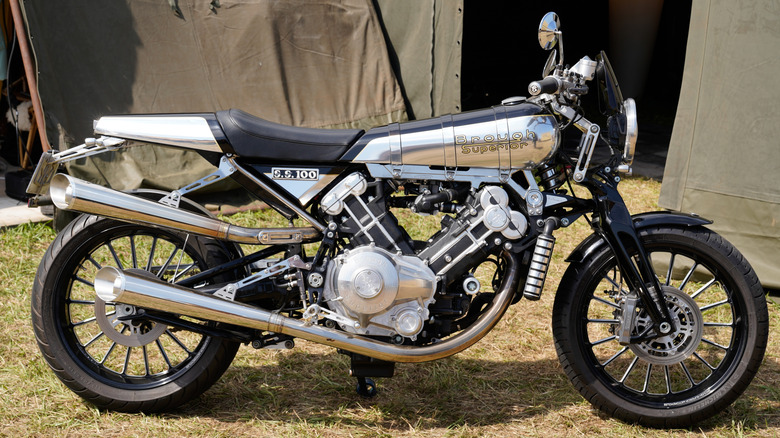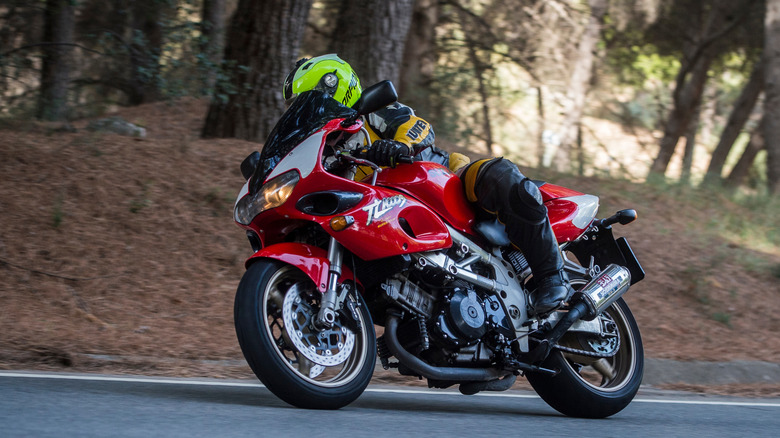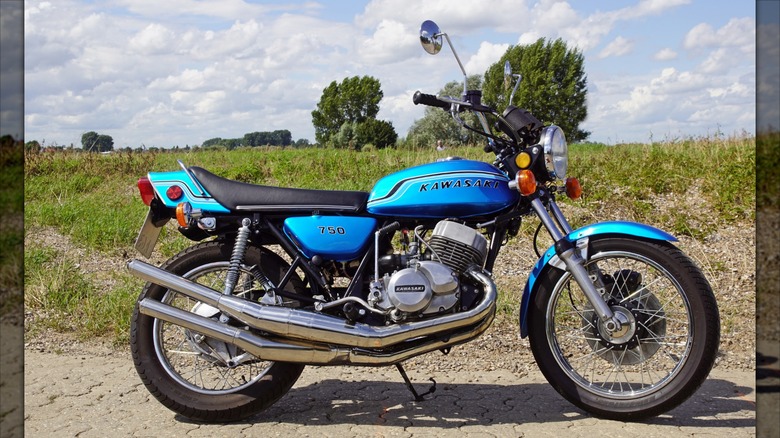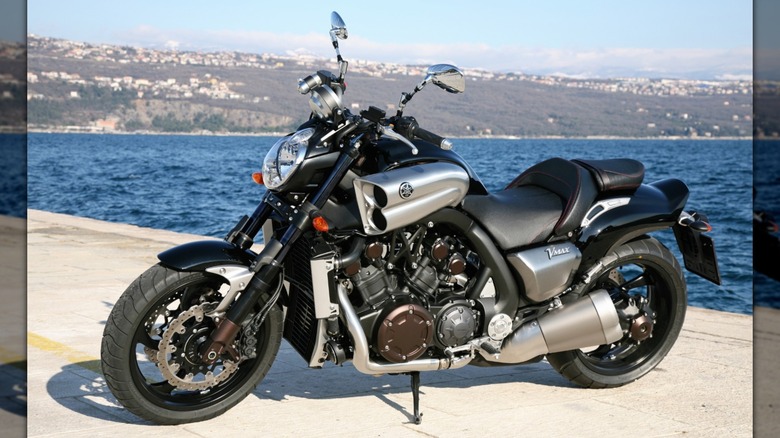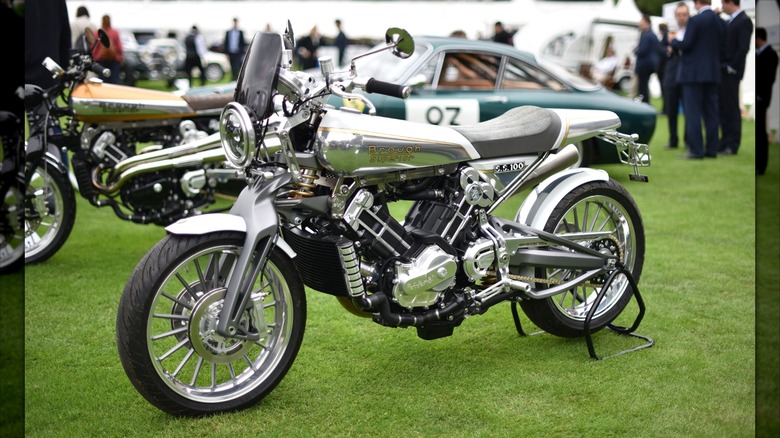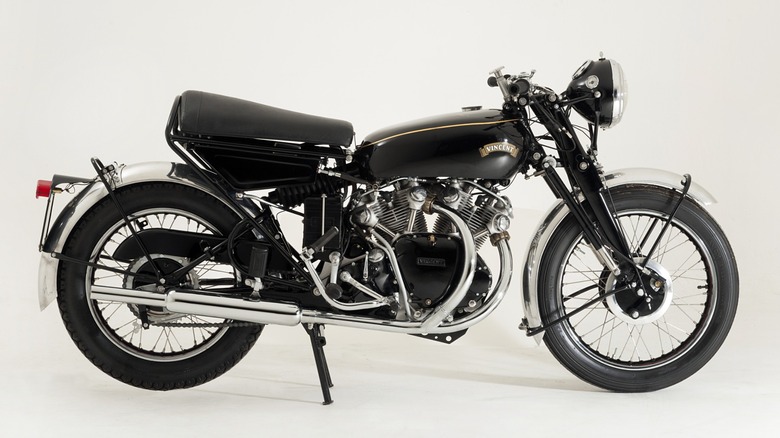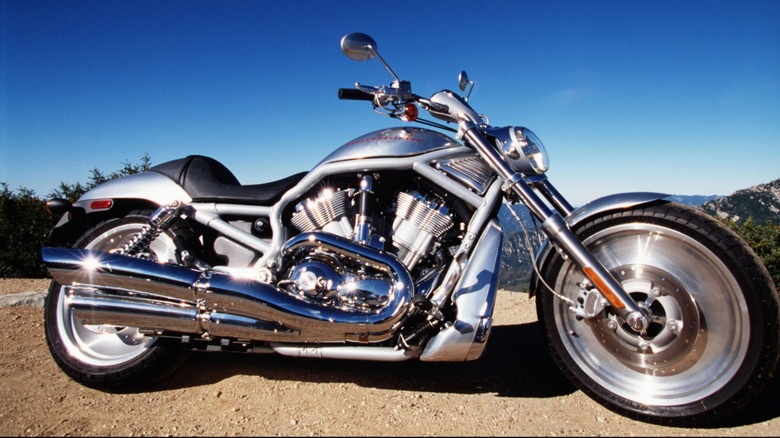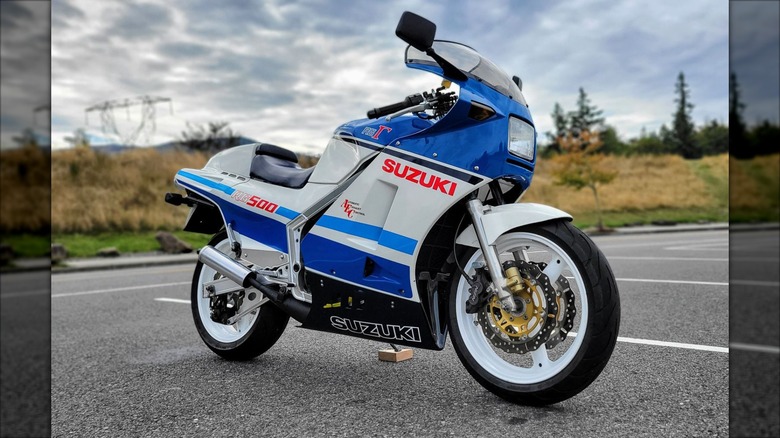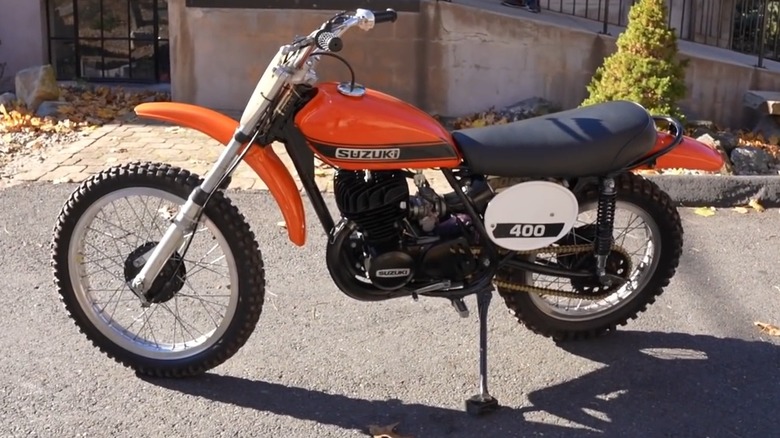8 Of The Most Dangerous Motorcycles Ever Made
Have you ever looked at the design for a dangerous seeming concept vehicle and thought to yourself, "Well, at least this thing is never seeing the light of day." If so, you might be surprised to find out that reality is often stranger than fiction. Some of the most outlandish and impractical designs have actually made it to production — sometimes with terrifying consequences for the unsuspecting riders who were just looking to enjoy a weekend cruise.
Some motorcycles are built for speed, while others are built for style. Then there are those which look like they're designed for a one-time use, both for itself and its rider. Whether due to poor engineering, overambitious innovation, or possibly a complete disregard for rider safety, these bikes have earned their reputations not just through their specs, but through the sheer number of crashes, recalls, and horror stories attached to them, sometimes all in that order.
Suzuki TL1000S
Aptly nicknamed the "Widowmaker," it had all the makings of a legendary sportbike, except for one small problem — it had a nasty habit of shaking riders off at high speeds. The bike suffered from an unforgivable design flaw in its rear suspension that made it nearly unrideable for anyone who enjoyed having their bones in one piece.
When Suzuki designed the TL1000S in the late '90s, they were aiming to take on Ducati's best. What they failed to account for, however, was that their innovative tech turned the bike into a mobile rodeo simulator. The problem lay in the rotary style rear damper, a novel but flawed piece of engineering that struggled to handle the heat and pressure. If pushed hard, it would overheat and lose its effectiveness, making the bike unstable in corners and prone to sudden tank slappers.
Suzuki even issued a recall, adding a steering damper to try and fix the issue, which it did for the most part, but the damage had already been done. I mean, sure, slap on a pair of modern tires and a new shock and you can barely feel anything off, but if I have to change the parts off a bike like a real life Ship of Theseus just to make it road safe, I think I'll take my chances elsewhere.
Some enthusiasts may insist that proper modifications can tame this faulty beast, but the fact remains -– no bike should need an aftermarket fix just to keep you from tasting asphalt. Suzuki learned its lesson the hard way, but the TL1000S still holds its place as one of the most unpredictable motorcycles ever made.
Kawasaki H2 750
If you thought the TL1000S sounds like a nightmare, wait till you hear about the original Widowmaker. If there ever was an award for the bike most likely to throw you into oncoming traffic, the Kawasaki H2 750 would win all three podium positions. This two-stroke rocket ship had a 750cc engine that delivered power like a sledgehammer — sudden and violently.
Kawasaki wasn't just trying to build a fast bike, they wanted the fastest one. This 750cc Mach IV was their answer to the horsepower arms race of the early '70s, boasting an insane 74 horsepower and capable of a blistering 126 mph top speed. It might have been a featherweight in its class, but that power-to-weight ratio made it a beast on the straights. Float like a butterfly, sting like a bee.
So, why is this my second pick for this list? Simple — because handling was an afterthought. The lightweight frame flexed like a rubber band under stress, and its short swingarm meant that the front wheel spent more time in the air when accelerating than it did touching the ground. Kawasaki tried to reign it in using steering dampers, but they were about as useful as strapping a parachute to a rollercoaster.
This oversight often resulted in a quick crash course in all three of Newton's Laws of Motion. Stricter regulations and an oil crisis in the 1970s spelled an end for the dangerous yet iconic Kawasaki H2, but not before securing its legacy and a spot on this list.
Yamaha V-Max
Just because you can cram a ridiculously powerful V4 engine into a motorcycle doesn't necessarily mean you should. This muscle bike was designed to be a drag racer you would take out onto the streets. It had an absurd power-to-weight ratio that made it feel like you were riding a barely contained explosion.
Released back in 1985, the V-Max was an instant hit. Riders were drawn by its raw power and aggressive style, but the bike's cornering abilities left much to be desired. The soft suspension and tendency to wobble at high speeds made it a challenge for anyone who dared ride it on anything but a straight line. True, Yamaha made some tweaks over the years, but the core issue remained — too much power, not enough finesse.
The secret behind this insane acceleration was the V-Boost system, which force-fed air into the engine at higher RPMs, adding an extra kick when you least expected it. It was exciting but unpredictable, kind of like getting pushed down the stairs while you're already skipping every other step.
While some managed to tame the beast, others found the bike too risky to handle. No wonder they used it as Ghost Rider's ride of choice in the second Nicolas Cage film. In fact, the iconic Hardy-Daytona from "Final Fantasy 7" also took inspiration from this dangerous beast.
Brough Superior SS100
If being known as the bike that claimed the life of T.E. Lawrence – better known as Lawrence of Arabia — and the fact that it is the reason why motorcycle riders are required to wear helmets by law isn't enough to convince you of its infamy, I don't know what will. Built during a time when 15 horsepower was considered daring, this 75 hp machine was essentially an overpowered racer sold to the public.
Designed by George Brough, the SS100 was a luxury speed demon in an age when most roads were barely more than compact dirt paths. Every model was custom-made for its owner and came with a guarantee that it could hit 100 mph. That's a bold claim to be making in the 1920s, and a terrifying reality considering the bike's engineering. Its speed far outpaced the era's braking and suspension technology, making it a death trap in all but the perfect road conditions. Lawrence's fatal crash in 1935 wasn't just a tragic accident –- it was a testament to just how dangerously ahead of its time this Rolls-Royce of Motorcycles was.
Today, the SS100 is nothing more than a collector's dream, holding the world record for the most expensive British bike sold at auction, going for a staggering £286,000 back in 2010, which is equivalent to about $370,000. Despite its history and value, the SS100 is best left in the past — humanity came up with modern safety features for a reason, and this Rolls Royce of risk came with none of them.
Vincent Black Shadow
Like the Brough Superior, the Vincent Black Shadow was the fastest production motorcycle of its time, hitting speeds that no one in the 1940s had any business reaching on two wheels. The Black Shadow was powered by a 998cc V-twin that cranked out 55 horsepower, a huge figure for its day. It easily reached 125 mph in an era when most cars barely scratched 70.
However, the bike wasn't built to handle that kind of speed — at least not in the sense that riders today would expect. The frame flexed unpredictably, and its brakes and suspension were similar to a horse-drawn carriage's in that if you twisted the throttle, stopping was more of a suggestion than a guarantee. This British-made legend was ahead of its time, but it's also terrifyingly unstable by modern standards.
Despite its flaws, the Shadow was a masterpiece of craftsmanship, inspiring one of the most famous motorcycle photos ever -– Rollie Free breaking a speed record in his swimsuit, which you can see for yourself on The Vintagent. Pair that with the fact that riding one of its variants, the Vincent Black Lightning, inspired Richard Thompson so much that he wrote a song about it, and you've got yourself one lean, mean machine.
Like the Superior, collectors salivate at the thought of owning a Shadow, with prices for one of the remaining 700 or so easily soaring into the six-figures. Still, heed the words of Hunter S. Thompson, who wrote in a 1995 issue of Cycle World that "If you rode the Black Shadow at top speed for any length of time, you would almost certainly die. That is why there are not many life members of the Vincent Black Shadow Society." Now that's saying something.
Harley-Davidson V-Rod
Harley-Davidson is known for classic cruisers with a focus on comfort and style, but the V-Rod was something different. It was built for speed, powered by a Porsche-designed engine, and was the fastest Harley of its time. However, riders quickly discovered that the limited cornering clearance meant that leaning too far would scrape the belly of the bike.
As if that weren't bad enough, its long wheelbase made it feel unstable at high speeds. It was a straight-line rocket but a nightmare in the curves. Still, Harley's attempts to break from tradition resulted in a machine that looked great and packed a serious punch. With its liquid-cooled 60-degree V-twin engine, the V-Rod produced up to 125 horsepower –- big numbers for a cruiser.
The long wheelbase, steep rake, and sheer weight made handling an afterthought. It was designed for drag strips, not for tight corners. This is ironic considering Harley did make a variant designed for drag racing. The non-street legal V-Rod Destroyer produced a staggering 165 HP. Let me put it this way: you needed a pro drag racing license just to be able to ride one, and then you could only do so on drag strips. So, naturally, Harley made 646 of them.
This radical departure also alienated some of its die-hard fans. Sure, it was fast, but it lacked the comfort and laid-back feel fans expected. Despite this, the V-Rod was quietly retired in 2018 after a respectable 16-year run, a bittersweet end for Harley's first real attempt at modern performance.
Suzuki RG500 Gamma
In the 1980s, Suzuki decided to give the public a taste of Grand Prix racing with the RG500 Gamma, a street-legal version of its GP race bike. The problem? It was completely unhinged. The 500cc two-stroke engine was known for having a ridiculously aggressive powerband. Below 6,000 rpm, it felt almost sluggish, but once it hit 9,000 rpm, all hell broke loose.
Suzuki essentially took its world-championship-winning square-four GP engine, softened it just enough to make it road-legal, and then sold it to unsuspecting riders. The result? A lightweight machine that handled beautifully if — and that's a big if — you could keep it under control. However, the unpredictable power delivery made it a ticking time bomb. A sudden and violent second power surge around 9,000 rpm meant riders often found themselves unexpectedly catapulted forward at dangerous speeds.
This mobile jumpscare demanded absolute respect. Riders who didn't know how to finesse the throttle were punished, and those who did were often left shook by its raw aggression. Despite all that, the RG500 is still considered one of the most successful Suzuki lines ever made, which says a lot about people's need for speed. Though it remains a cult classic to this day, the Gamma was a terrifying reminder that just because you can make something street-legal, doesn't mean you should.
1971 Suzuki TM400
Suzuki makes its way back on the list with the TM400, also known as Cyclone. Suzuki wanted to dominate the motocross scene in the early '70s, so they crammed a ridiculously overpowered 396cc two-stroke engine into a frame so light and flimsy it couldn't handle the power.
The result? Terrible stability, unpredictable handling, and a powerband so erratic that it would randomly kick in at different rpm levels, often launching riders into the air at the worst possible moment. Its ignition system was unreliable, and the frame was weak enough to flex even on smooth terrain. Experienced motocross riders found it barely manageable. For beginners? It was almost a guaranteed trip to the hospital.
So who do you think was tasked with the unveiling of this ticking time bomb? None other than Captain Kirk himself. At a glitzy Warner Studios event, William Shatner convinced an audience of journalists that they were about to witness the next great motocross revolution. Unfortunately, Scotty couldn't beam him up from this disaster, and no amount of Starfleet charm made the bike any less of a deathtrap.
If you don't want to take my word for it, take Jody Weisel's. One of the most experienced motocross editors in history, who's tried just about every motocross bike made in the last 40 years, summed it up best in an article for MXA by writing, "Criticizing the 1971-74 Suzuki TM400 is like picking low-hanging fruit—it is too easy. It is the poster child for the phrase 'injury forces sale.' ... If you expected bad things to happen, it never disappointed you."
